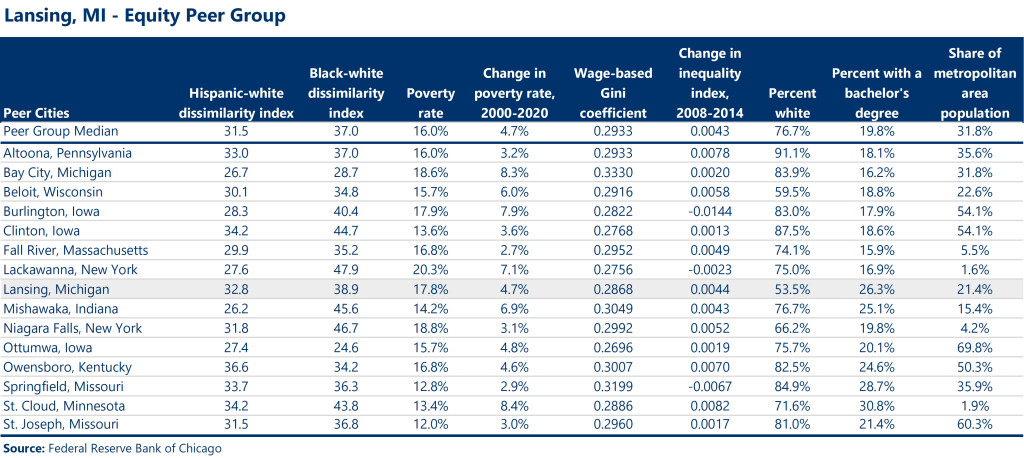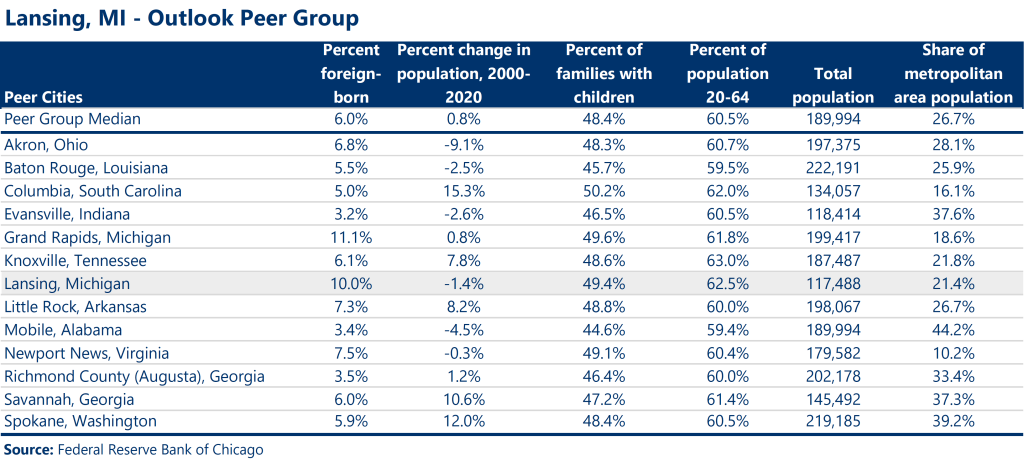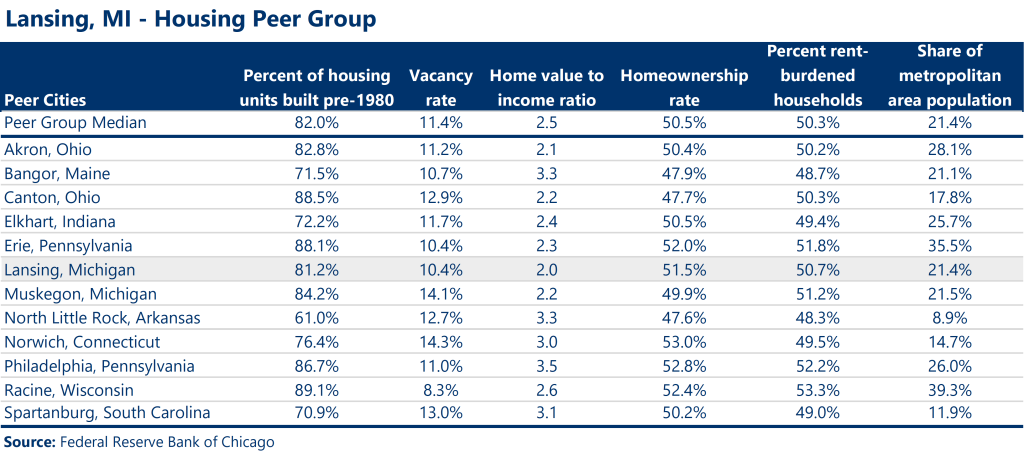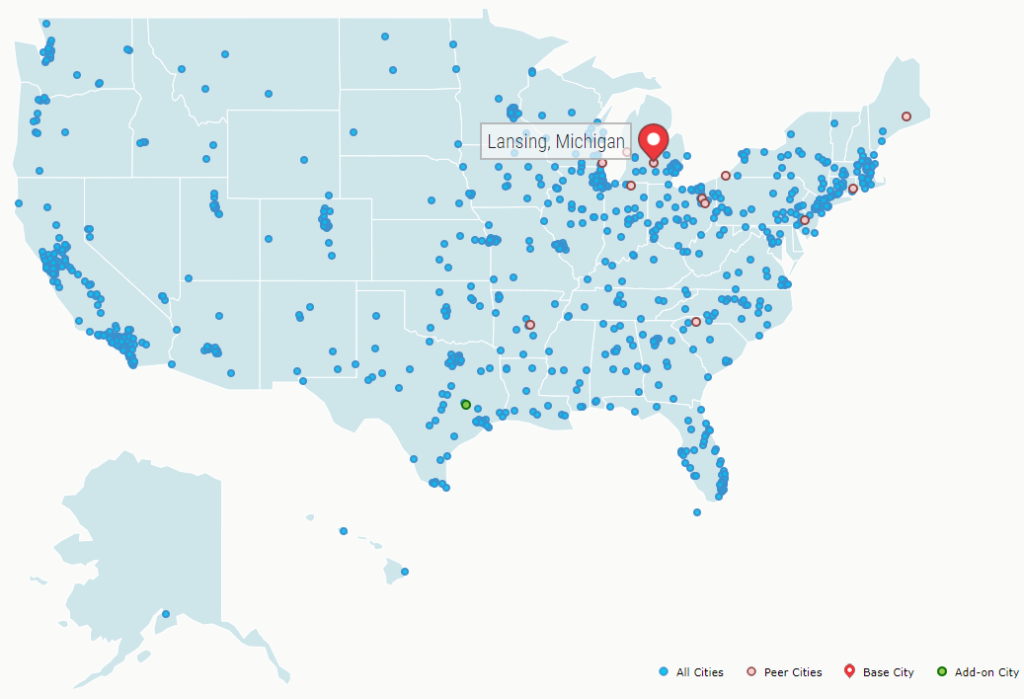- Navigator
- Featured Indicator
- Industry Analytics
- National
 The Federal Reserve Bank of Chicago offers a Peer City Identification Tool that allows users to conduct a quick cluster analysis to identify groups of similar cities along economic, demographic, social, and housing dimensions.
The Federal Reserve Bank of Chicago offers a Peer City Identification Tool that allows users to conduct a quick cluster analysis to identify groups of similar cities along economic, demographic, social, and housing dimensions.
The tool draws on city-level indicators from the American Community Survey and decennial US census to provide data comparison and visualization that can help policymakers better understand a municipality within the context of its peer cities.
The Peer City Identification Tool includes coverage of 960 places from around the United States that were either incorporated with a population of at least 25,000 by the 1960 census or incorporated with a population of at least 50,000 by the 2010 census.
Peer cities are grouped along four key themes:
- Equity: addresses questions regarding inclusion, access, and diversity using the wage-based Gini coefficient, race and ethnicity-based dissimilarity indices, changes in poverty levels, and educational attainment.
- Resilience: speaks to issues related to economic diversification by considering current conditions and trends in manufacturing employment, labor force participation, and unemployment.
- Outlook: explores signs of a city’s demographic and economic future by incorporating immigration, family composition, age structure, and changes in total population. The age distribution of a population, net migration, and family composition provide clues about a city’s future.
- Housing: speaks to issues of affordability by incorporating data relating to home ownership (income-to-home value ratio and homeownership rate) and renting (rent burden), the quality and competitiveness of housing stock (using the age of housing as a proxy), and housing vacancies.
What is the Data Telling Us?
Michigan’s capital city, Lansing, is used here to illustrate the utility of the tool. The tool allows you to pull a unique set of peers for each of the four themes.
For example, Lansing has 14 peer cities in the equity theme, including places such as Niagara Falls, NY and St. Cloud, MN.
 In terms of resilience however, only five peers are returned based on measures such as unemployment, labor force participation, and share of metropolitan area population. Only Bay City, MI is a peer for Lansing in both equity and resilience.
In terms of resilience however, only five peers are returned based on measures such as unemployment, labor force participation, and share of metropolitan area population. Only Bay City, MI is a peer for Lansing in both equity and resilience.
 Twelve of Lansing’s peers are identified on measures related to outlook, including data on percent of foreign-born population and percent change in population. Akron, OH appears on the peer lists for both resilience and outlook.
Twelve of Lansing’s peers are identified on measures related to outlook, including data on percent of foreign-born population and percent change in population. Akron, OH appears on the peer lists for both resilience and outlook.
 Within the housing theme, 11 peers are identified, again including Akron, OH. Peers in this theme are based on data related to age of housing stock, homeownership rates, and percent of rent-burdened households, among others.
Within the housing theme, 11 peers are identified, again including Akron, OH. Peers in this theme are based on data related to age of housing stock, homeownership rates, and percent of rent-burdened households, among others.
 Identification of peers is not always a black and white process that can be completed using the sample of indicators used here. In cases where users have other peer cities in mind, the tool provides flexibility in allowing users to add cities to the list that are not returned by default.
Identification of peers is not always a black and white process that can be completed using the sample of indicators used here. In cases where users have other peer cities in mind, the tool provides flexibility in allowing users to add cities to the list that are not returned by default.
In addition to the data tables, a map of peer city locations is available on the site. Below is an example of the map, displaying Lansing’s housing peers, with College Station, TX added as a custom peer. On the Federal Reserve Bank of Chicago’s site, the map is interactive; hovering over any city shows users the name of that city which can then be selected to update the data and return peers for the selected city.

Why is Peer City Identification Important?
Through our work, we’ve found that there is often a desire by communities to benchmark their performance against similar cities. This type of comparison can be useful for communities that are working to develop a strategic plan, expand an industry, or identify real estate gaps. But if a community hasn’t already identified its peer cities, a comparison can be challenging to complete and requires extensive research. The Federal Reserve Bank of Chicago’s Peer City Identification Tool offers a quick and easy way to identify potential locations against which cities can benchmark themselves. This is a good starting place to generate ideas for similar places, while also allowing flexibility for the addition of custom peer cities.
Camoin Associates is a national leader in using research and data analysis to help communities and organizations understand where they are now and develop actionable goals designed to get them where they want to be. Learn more about our services.





